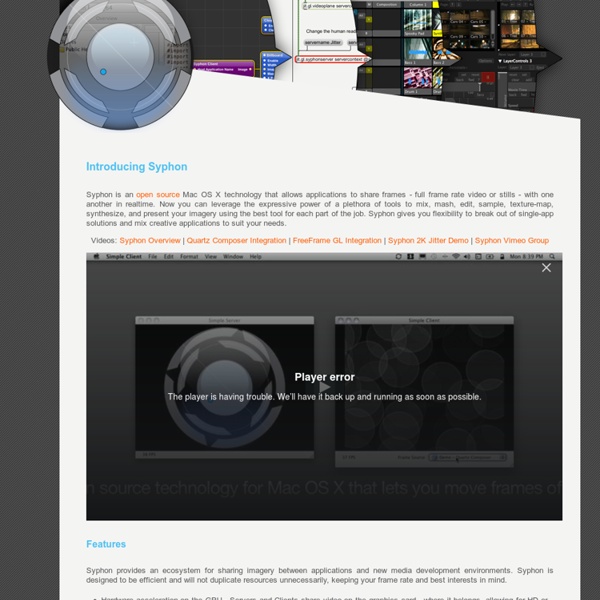



Millumin SIGMASIX Syphoner CoGe VJ - Modular VJ software for Mac OSX CoGe VJ is a semi-modular VJ software, which means you can build the environment that suits you the best, and you won't be stuck with a pre-defined interface. You are only limited by the maximum performance of your computer's graphics card and, of course, your imagination. Mix and composite multiple sources, apply stackable effects, automate with sequencers and control surfaces! Audio Analysis in CoGe VJ allows you to modulate parameters using incoming sound. CoGe isn’t a picky VJ software. Legendary support We are always here to help if you need - we aim to get back to all messages within 24 hours but we're usually much faster!
Canon Digital Camera Software Developer's Kit Canon Digital Camera Software Developers Kit General Information Current SDK Versions as of November 13, 2014 EDSDK 2.15 for EOS digital cameras What are the Canon Digital Camera SDKs? SDK stands for Software Development Kit. EDSDK 2.15 Windows version for select EOS Digital SLRs EDSDK 2.15 Macintosh version for select EOS Digital SLRs The Canon Digital Camera SDKs comprise a set of APIs, DLLs, and static link libraries that provide an interface for accessing Canon digital cameras and data generated by Canon digital cameras. EDSDK 2.15 Windows and Macintosh version support remote control for some EOS cameras, RAW image conversion and downloading from select EOS Digital SLRs with DIGIC 4, DIGIC III or DIGIC II processors released over the past five years, starting with the EOS-1D Mark III and continuing through to the EOS-1D X. All Canon Digital Camera SDK versions are written in C. PLEASE NOTE:EDSK is not 64-bit compatible. Additional Notes on this release
Max: Cycling 74 Collega e Crea Max ti dà gli strumenti per creare suoni unici, grafica e video stupefacenti, interazioni multimediali affascinanti. Questi strumenti si chiamano ‘objects’ (oggetti): piccoli elementi grafici programmati per svolgere un compito specifico. In Max puoi aggiungere gli oggetti su una “tela virtuale” e connetterli tra loro con dei cavi. Oggetti che Connettono Con il supporto nativo per un’ampia gamma di controller e dispositivi, Max ti consente di mettere in connessione tutto quello che vuoi. Max nella tua Attività Creativa e Professionale La grande quantità di funzioni e l’interfaccia accessibile ha reso Max uno strumento indispensabile in una grande varietà di discipline dove è richiesta interattività e manipolazione di media in tempo reale. Max nelle Scuole e nelle Università Gli studenti che conoscono altri linguaggi di programmazione troveranno in Max il supporto nativo per JavaScript, Java e C. Risorse Forum su Max/MSP in italiano (Virtual Sound)
MWM - Realtime 3D mapping What is Vuo? | Vuo After the show… Latesha: Great VJ set. How did you make those graphics? Lupe: With Vuo. I'm an artist. Latesha: I've got a gig next month for The Queen of Pop. Lupe: Yeah! Latesha: Hey, could I make each building appear in sync with the beat? Lupe: Mm-hm. Latesha: Oh! Lupe: Put some force sensors on the stage, connect them to an Arduino, and feed that into Vuo. Latesha: And I want to make the stagelights flicker and shoot fireworks. Lupe: Vuo can control stage equipment. Latesha: I bet I could use Vuo to make the promo video, too. Lupe: Right. Latesha: Thanks for your help! Lupe: No problem.
untitled Introduction The Canon EOS Digital SDK is a quite powerful SDK to remote control Canon DSLRs. Unfortunatly it is quite difficult to find some good examples for it on the internet and the provided documentation is not very complete. Since I have found out many things already and want to make it easier for others I thought I could compile some of the most important things together and do a tutorial. This tutorial includes: Init and terminate the SDK Get connected cameras Open and close a session with a camera Get and set camera settings Get a list of available settings Take photos (normally and in Bulb mode) Record videos Press the shutter button remotely Download data (images, films) from the camera Start and view the live view Control the focus Lock and unlock the camera UI Get an image thumbnail Get folders and files on the camera Note: I'm not affiliated with or funded by Canon Inc. in any way I do not guarantee for this software in any way. Full Library Background Using the code
Max (Wikipedia) Max is a visual programming language for music and multimedia developed and maintained by San Francisco-based software company Cycling '74. During its 20-year history, it has been used by composers, performers, software designers, researchers, and artists for creating recordings, performances, and installations. The Max program itself is modular, with most routines existing in the form of shared libraries. An API allows third-party development of new routines (called "external objects"). Miller Puckette originally wrote Max at IRCAM in the mid-1980s, as the Patcher editor for the Macintosh to provide composers with an authoring system for interactive computer music. In 1989, IRCAM developed and maintained a concurrent version of Max ported to the IRCAM Signal Processing Workstation for the NeXT (and later SGI and Linux), called Max/FTS (FTS standing for "Faster Than Sound", and being analogous to a forerunner to MSP enhanced by a hardware DSP board on the computer).[3][4]
Z Vector | The depth camera visualization tool